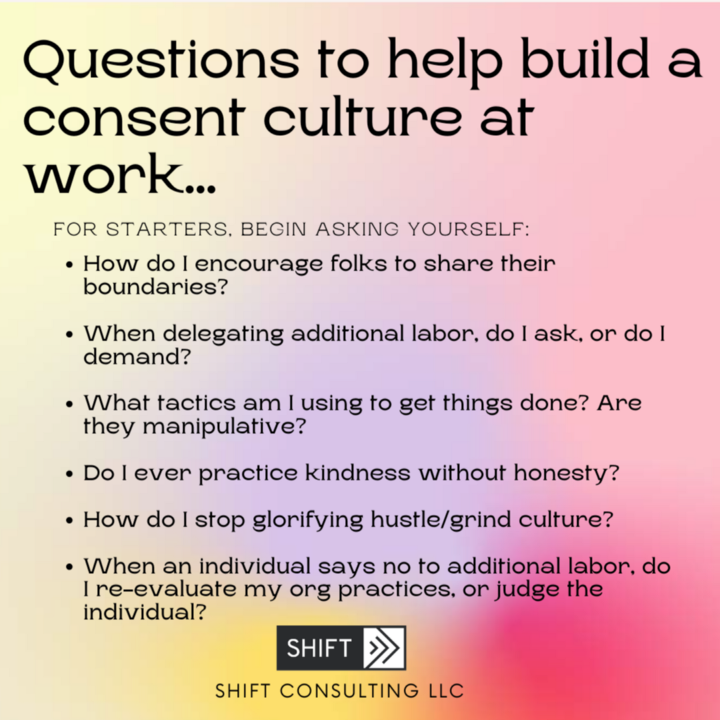Building a Culture of Consent in the Workplace
Reimagining a Culture of Consent.
Since the #metoo movement, conversations around consent have deepened past the antiquated understanding of “no means, no”. This understanding also solely centers the “no” of consent. While that is a part of boundary setting, we are also excited by the ways in which we can center the affirmation of consent with a “yes!!” a freely given, reversible, informed, enthusiastic, specific YES.
As our culture continues to deepen this understanding and unpack the ways we have normalized a lack of consent or rape culture in our everyday interactions (beyond sexual relationships) SHIFT has been exploring how this all specifically shows up within the workplace. As conversations around navigating boundaries and limitations at the workplace become louder, so does our need to envision — what does a culture of consent actually look like?
At SHIFT, we define a culture of consent where all people are respected and have autonomy, choice, and agency, to decide for themselves what is best and right for them. It is about our relationships and society at large, in all interactions.
Consent needs to be everywhere, because abuse can show up anywhere.
In order to build a consent culture we have to get honest about the barriers and prevent us from creating one. Abuse of power, and a culture of violence is perpetuated through capitalism, white supremacy, homophobia, transphobia, ableism, and all systems of oppression. It is our responsibility to recognize the ways these characteristics are deeply normalized and embedded in our daily culture.
We’ve highlighted 4 areas where we see workplaces perpetuating a culture of abuse through the normalization of gaslighting, coercion, victim blaming, and slut-shaming.
Gaslighting: “I don’t believe that ever happened. And if it did, I never meant for it to come off that way.”
Coercion: “Can you please just stay longer to meet that deadline?”
Victim Blaming: “Why didn’t you report it sooner?”
Slut Shaming: “She/ they must have slept with so and so to get that position.”
We should also ask: how do these examples shift when we think about who is saying them- our boss? our white colleague? our male peer or assistant? Within a workspace, (and beyond) there are always formal and informal power dynamics informing someones access to building a consent culture. The more we are able identify ways we internalize and externalize systems of power and abuse, the closer we are to building a culture of consent.
The possibilities to practice consent are infinite.
Here are some questions to begin to ask yourself to get started — to find out what works for you, your org, and team.
Other things to consider:
How do we challenge our right to comfort when feeling challenged or in conflict?
How do we build a culture where we can practice mutual accountability?
How can we begin to recognize the act of forming and sticking to boundaries as a form of care, especially to avoid burnout?
Creating a culture of care directly challenges a culture of abuse and violence that white supremacy culture, and other systems of oppression create. The possibilities are infinite, and affirms and humanizes the different ways we as individuals express need, accountability, boundaries, and care for one another. What would shift if we…
Considered what our colleagues and staff were holding outside of workspaces
Encouraged mental health days, breaks, vacations, and humanizing check-ins
Practiced more radical honesty when met with community accountability
Demanded that all workers everywhere were deserving of respect and dignity no matter title, salary, or identities
We believe that centering care is part of the solution to helping us envision what a culture of consent can be, and directly disrupts the systems of white supremacy, capitalist, patriarchy.
Art by David Hernandez




